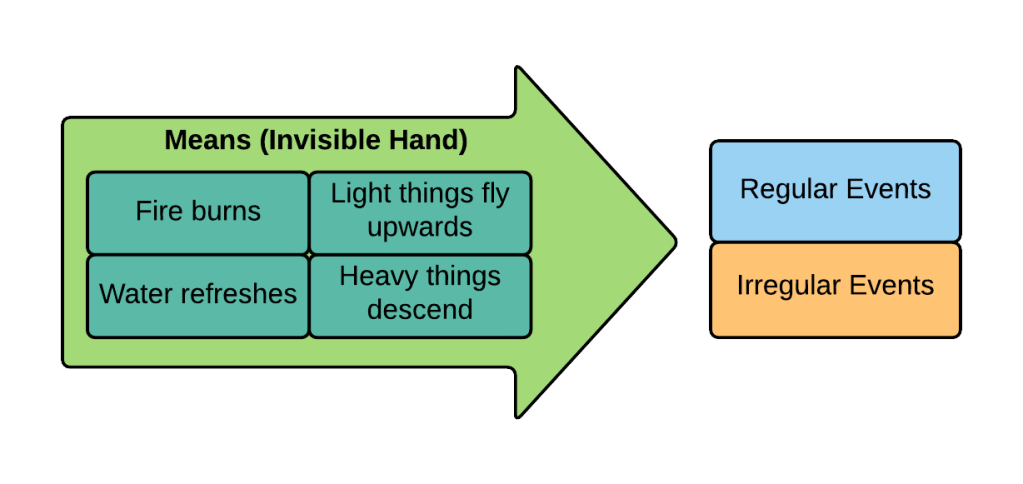In the previous post, we defined the Invisible Hand in The Wealth of Nations (WN) and The Theory of Moral Sentiments (TMS) as having four main factors and one factor related to economics:
- Belief in a Supreme Being, which may or may not be the same as the Christian ‘God’ depending on one’s definition
- A Principle of Self-Motion (Self-Interest or Lack of Sympathy)
- Human Communication
- Sympathy, manifesting as the ability to make agreements and promises
- Production = Consumption or Revenue
However, the non-sympathy in the Principle of Self-Motion obviously contradicts the sympathy needed for employment and trade. We explain that the difference is complementary, not contradictory, and is a necessary effect of the duality of the universe.
Explanation 1A (Main):
To do that, we first need to define the invisible hand by bringing up its third idea as explained by Smith, in red color:
Hence the origin of Polytheism and superstition which ascribes all the irregular events of nature to the favour or displeasure of intelligent, invisible beings, to gods, demons, witches, genies, and fairies. In all Polytheistic religions, among savages and in the early ages of Heathen antiquity, only the irregular events of nature are ascribed to the agency and power of their gods. By the necessity of their own nature: fire burns, water refreshes, heavy bodies descend, lighter substances fly upwards. The invisible hand of Jupiter was never perceived in those matters. But the more irregular events were ascribed to Jupiter’s favour or anger: storms and sunshine, thunder and lightning. Savages only knew the designing power of man. Man stops or changes the course of natural events. They imagined those other intelligent beings, were naturally supposed: to act in the same way, to not support the ordinary course of things, which went on of its own accord, to stop, thwart, and disturb the ordinary course of things. Thus, in the first ages of the world, the lowest and most cowardly superstition supplied the place of philosophy. (Simple Essays, Origin of Philosophy)
Its basic ideas are:
Red idea : Early man thought that the gods were like himself, who would only cause, through an invisible hand, the irregular events of nature, not the regular ones.
Sea green: Regular physics follows its own nature.
In a nutshell, early men wrongly thought that the acting principles behind the irregular events of nature were different from those behind the regular ones.
Explanation 1B (Supporting)
Nowadays, thanks to scientific advancement which explains physical laws such as gravity, pressure, thermodynamics, etc., we know that the principles behind the irregular events are the same as the regular ones. Early men could not make the connection because of ignorance arising from a difficult life, but eventually could make the connection, thanks to law and the original principle of wonder:
But when law has established order and security, and subsistence ceases to be precarious: Mankind’s curiosity of mankind is increased, and their fears are reduced. They enjoy leisure which renders them: more attentive to the appearances of nature, more observant of her smallest irregularities, and more desirous to know the chain which links them all together.. Their imagination easily and delightfully accompanies the regular progress of nature. It is stopped and embarrassed by those seeming incoherences which excite their wonder, and seem to require some chain of intermediate events. By connecting those events with past events, the whole course of the universe may be rendered consistent and of a piece. Wonder, therefore, and not any expectation of advantage from its discoveries, is the first principle which prompts mankind to the study of Philosophy. It is the science which pretends to open the concealed connections that unite nature’s various appearances. Man pursues this study for its own sake, as an original pleasure or good in itself, without regarding its tendency to procure them the means of many other pleasures. (Simple Essays)
Thanks to wonder, the invisible hand or inherent principles which cause natural physical phenomena, coming from a non-Polytheistic Supreme Being, could be known. We thus add the principle of wonder to our previous graphic of the invisible hand:

We also create a graphic for the invisible hand of physical phenomena:

But the question arises: Why are there two invisible hands? What is the Invisible Hand in the first place? Why couldn’t Smith just use the word nature for inherent principles and say human nature to describe the dynamics of human behavior and physical nature to describe that of physics?
The Ambiguity and Insufficiency of the word ‘Nature’
This is because the word ‘nature’ lacks the ability to convey the many smaller ideas that are carried by the word ‘invisible hand’. For one thing, ‘nature’ does not carry with it an idea of a Supreme Being. David Hume defines nature as something common, non-miraculous, or non-man-made. Even the current definition of ‘nature’ has no reference to a Supreme Entity. We do not pray to ‘Mother Nature’ for prosperity, for example, because we know the idea represented by Mother Nature is not the same as the idea of an all-knowing and all-caring Providence.
The word ‘invisible hand’, however, automatically implies an idea of an invisible, omnipresent, all-knowing entity that is actively operating on all phenomena in the universe, leading to a certain end or effect. Thus, we can say that the Supreme Being is the cause which works through an invisible hand or means to produce a certain effect in the universe. We can also say that the invention of the word ‘invisible hand’, with its ideas, is Smith’s contribution to Western philosophy just as the use of the word ‘ego’ was a contribution by Freud. However, the problem with the invisible hand is that Smith did not define it fully. Instead, he just saw it and described it, without exploring it in detail, as to give a better definition. This lack of definition led to its misinterpretation and misunderstanding, and here raises the question why there are two invisible hands.
To clear up all misunderstandings about it, and put its explanation beyond all doubt, we look to Eastern Philosophy*, originating from India, which is much older than Western Philosophy and thus has not only also seen the invisible hand, but has also studied it in detail, allowing us to define it conclusively in the next post.
In fact, in examining the ideas of Western philosophers such as Hume, Smith, Marx, and Mill. I have used Eastern Philosophy as the expert judge, to see which ideas would lead to inconsistency or fallacy, and which ones would be solid enough to be regarded as part of a universal truth, able to stand the test of time and space.




